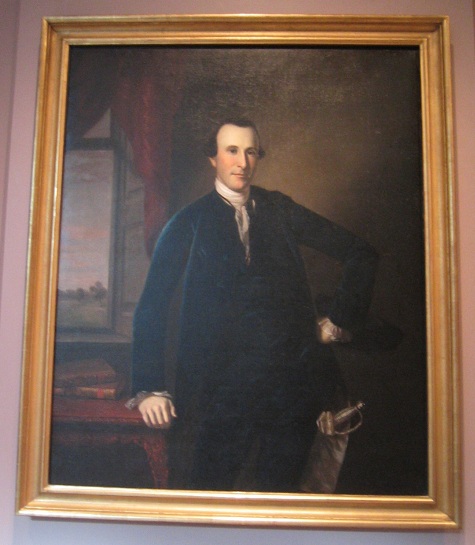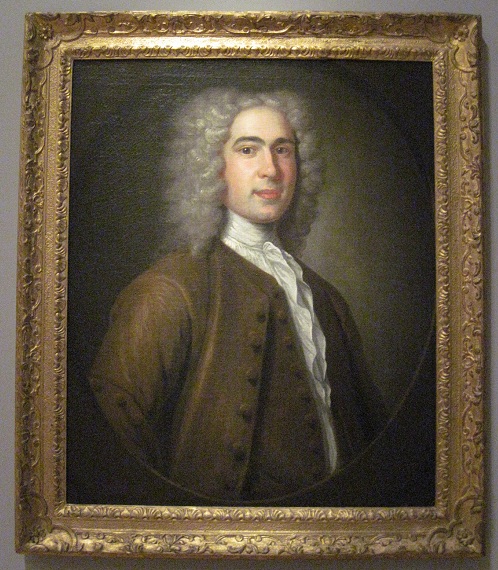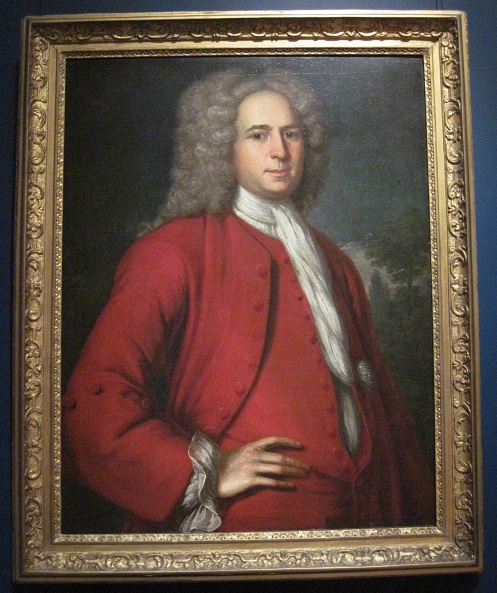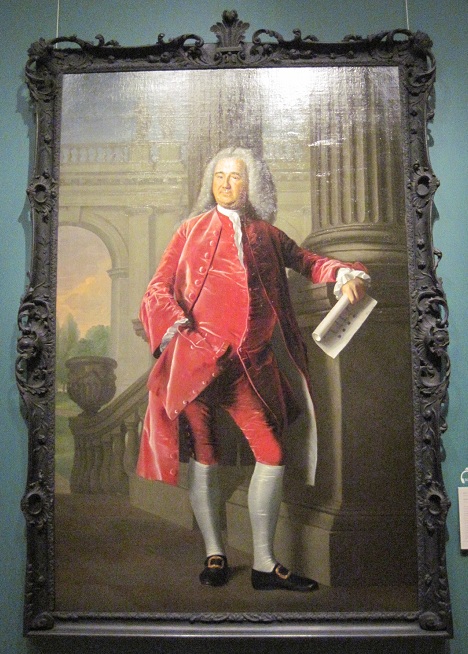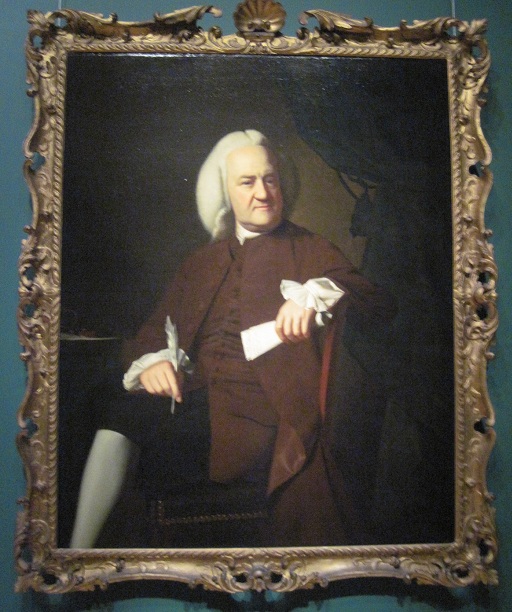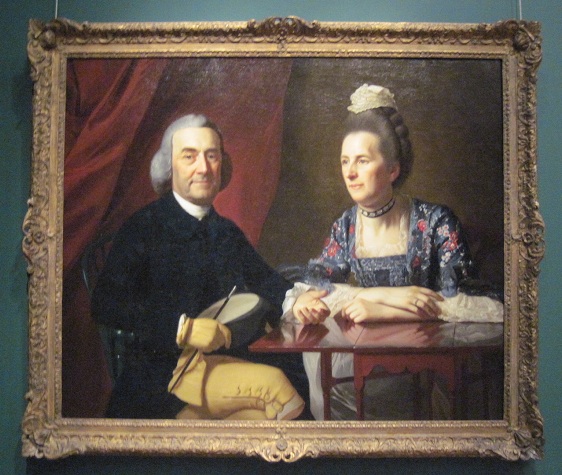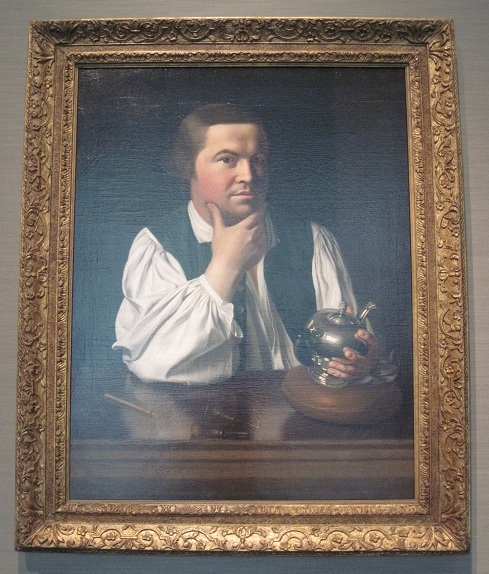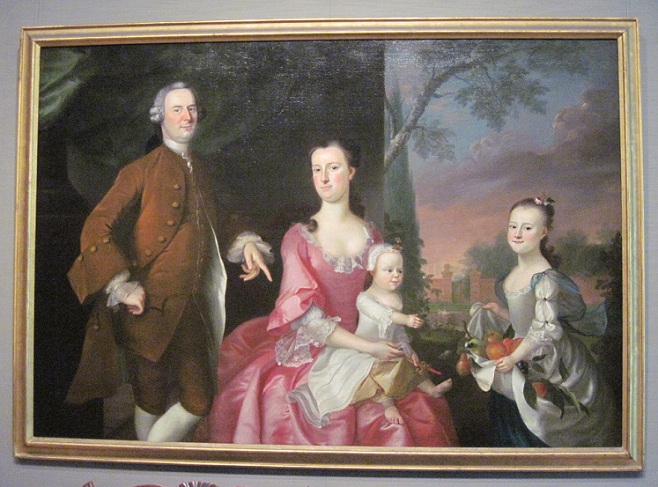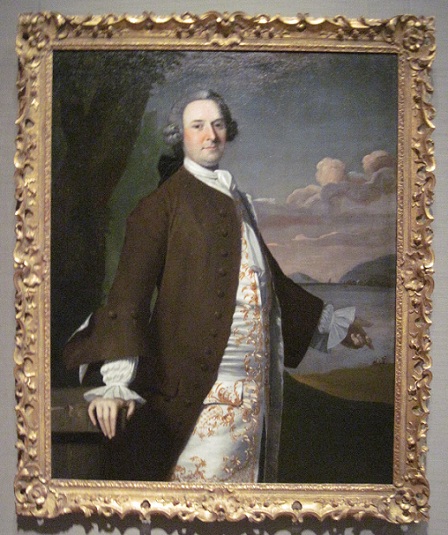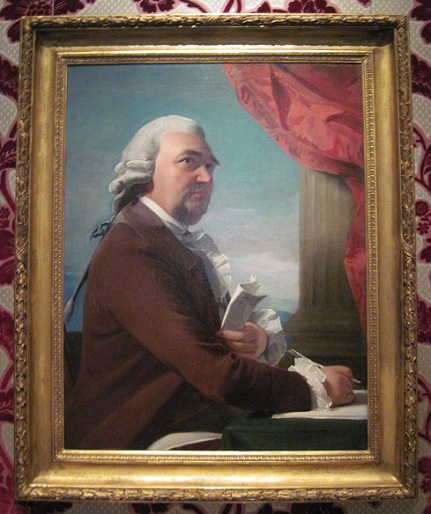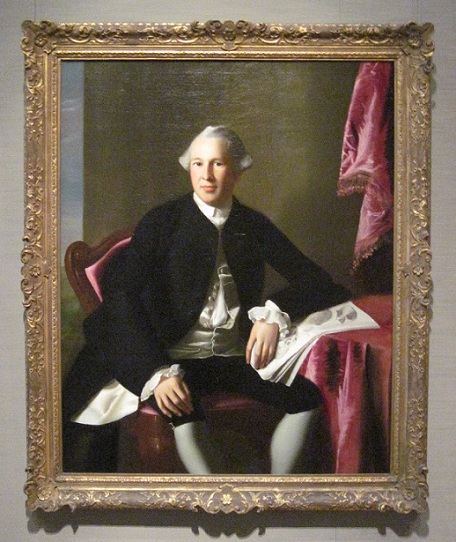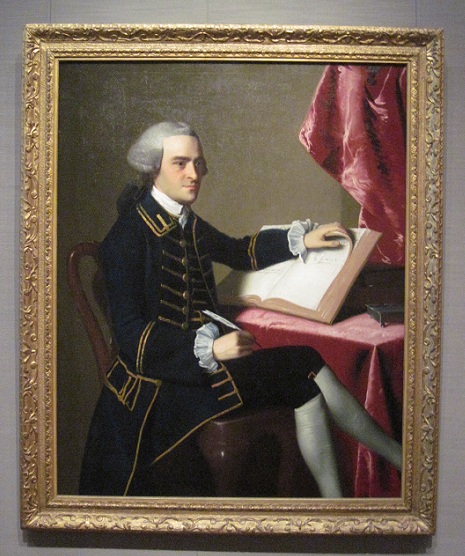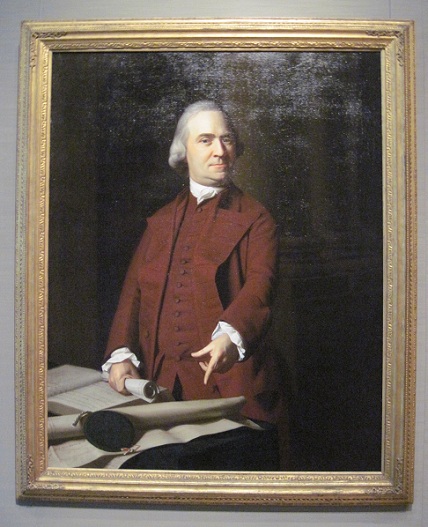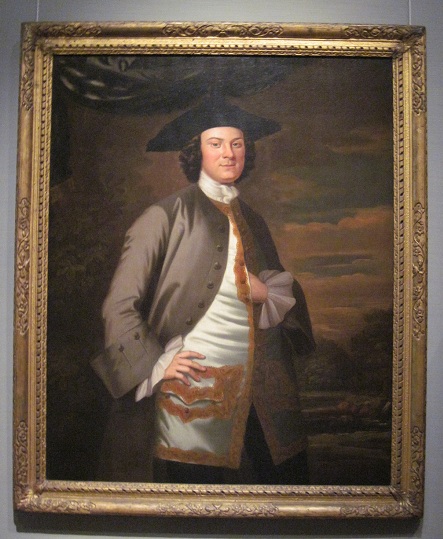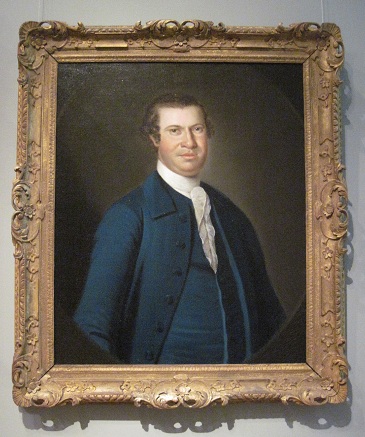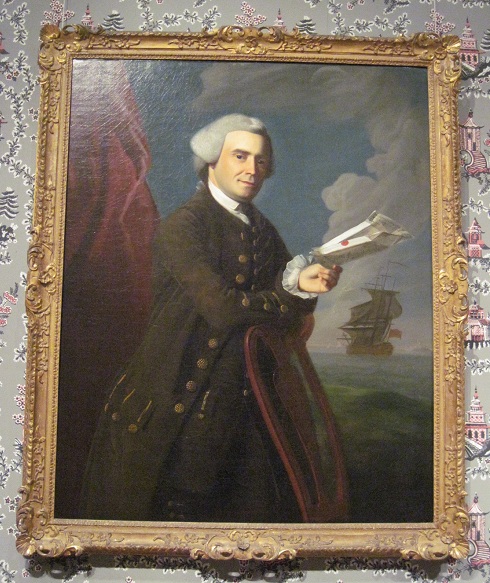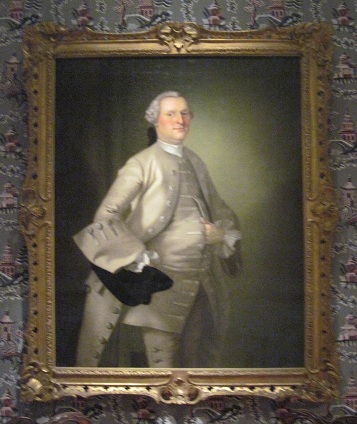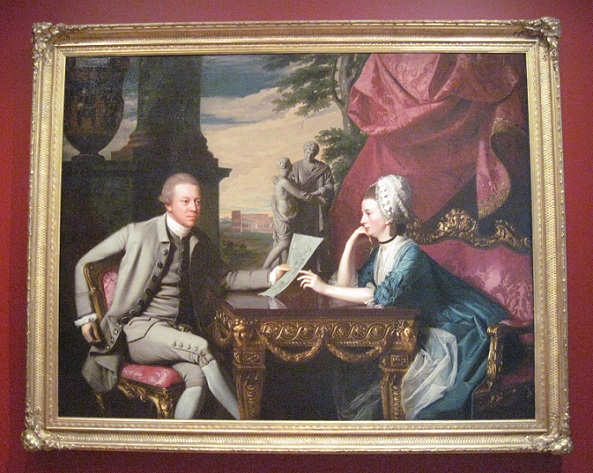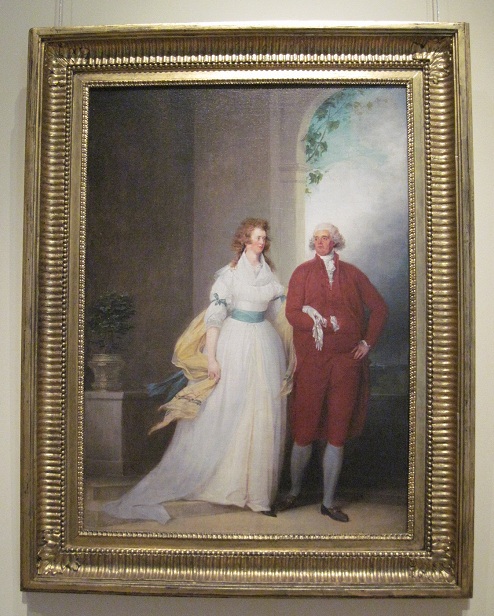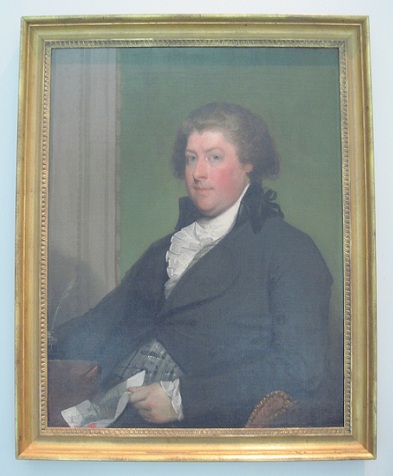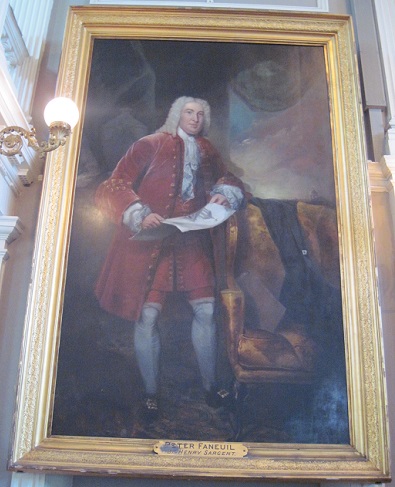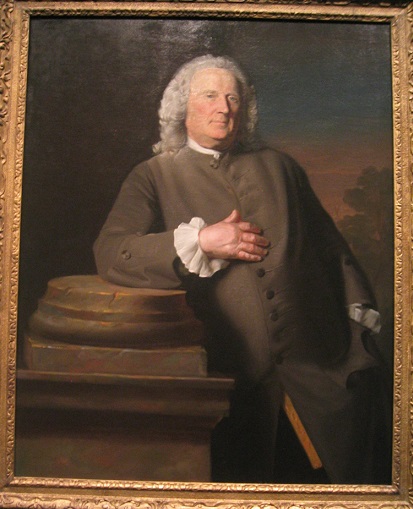Subject: gentleman officer
Culture: Colonial-Revolutionary Anglo-American
Setting: 13 Colonies, American Revolution, North America 18thc
DeWitt Wallace Decorative Arts Museum > Masterworks *
"BENJAMIN HARRISON Charles Willson Peale (1741-1827) Virginia, 1775 Oil on canvas ...
Charles Willson Peale recorded his subject's status with subtlety, minimizing the showy materialistic details that most of his wealthy clients enjoyed displaying more openly. As an example, Benjamin Harrison (1743-1807) wears a miniature portrait on a ribbon around his neck, but the costly object is only half visible, tucked beneath the edge of his waistcoat. Similarly, lack of sharp highlighting and low contrast with the background downplay the expensive carved decoration on Harrison's table. Indeed, restraint and elegance characterize every aspect of Peale's sensitive likeness.
* Museum of Fine Arts > Art of the Americas
"John Smibert American (born in Scotland), 1688-1751 John Turner, 1737 Oil on canvas
A merchant from Salem, Massachusetts, John Turner was one of the early owners of the mansion now called the House of Seven Gables. Smibert shows him with a hand extended toward the ships in the harbor, as if to remind of the source of the family's prosperity. Many Smiberts have come through time in relatively poor condition, with abraded surfaces. But parts of this painting, especially Turner's sleeve, survive almost as new. Look for the closely spaced diagonal brushstrokes in the sleeve; they are characteristic of Smibert's technique." ...
Museum of Fine Arts > Art of the Americas *
"John Smibert American (born in Scotland), 1688-1751 Daniel, Peter, and Andrew Oliver, 1732 Oil on canvas
This portrait captures a conversation among three sons of a prominent Boston family, but it is deceptively lively. Peter (center) and Andrew (right) went on to long and distinguished political careers, but Daniel (left) had died of smallpox five years before. Smibert took his likeness from a portrait miniature, reuniting in paint three brothers who could never again be together in life." ...
* Museum of Fine Arts > Art of the Americas
"John Smibert American (born in Scotland), 1688-1751 Thomas Hancock, 1730 Oil on canvas
Different-sized portraits cost different amounts. According to Smibert's notebooks, a three-quarter view like this was the cheapest. Thomas Hancock would go on to be one of the richest and most powerful men in Boston, but in 1730 he was still building his fortune. He commissioned this portrait and one of Lydia Henchman on the occasion of their marriage. When Thomas died, his nephew John became beneficiary of his estate and among the wealthiest Bostonians of his generation." ...
Museum of Fine Arts > Art of the Americas *
"John Smibert American (born in Scotland),
1688-1751 William Dudley, 1729 Oil on canvas
Smibert's arrival in Boston from London in 1729 caused something of a sensation. Here was a painter who could provide sophisticated portraits in an up-to-date style; he was busy with commissions almost as soon as he arrived. Son of a governor of Massachusetts, William Dudley was a prominent local politician." ...
* Museum of Fine Arts > Art of the Americas
"John Singleton Copley American, 1738-1815
Nathaniel Sparhawk, 1764 Oil on canvas
Nathaniel Sparhawk was a rich merchant and owned a fine house in Kittery, Maine. But in this portrait Copley shows him at ease in a settling [SIC] far grander than his actual home. This was Copley's first life-sized, full-length portrait, and he based the composition on traditional European images of heroes and aristocrats. Sparhawk's velvet suit reinforces this impression. If you look closely at his waistcoat, you can see shadowy indications of another set of buttons, revealing that Copley reworked the painting to increase his sitter's girth; excess weight was a sign of health and prosperity." ...
Museum of Fine Arts > Art of the Americas *
"John Singleton Copley American, 1738-1815 Ezekiel Goldthwait, 1771 Oil on canvas
Goldthwait, from one of Boston's most prosperous families, lived in the North End and spent most of his life in public office. Just before Copley painted this portrait, Goldthwait defeated Samuel Adams in an election for registrar of deeds of Suffolk County. Copley alluded to Goldthwait's profession as a record keeper by showing him seated at a desk, quill and papers in hand.
Frame: Both of the Goldthwait portraits still have their original frames, selected by Copley and carved by John Welch." ...
* Museum of Fine Arts > Art of the Americas
"John Singleton Copley American, 1738-1815 Nicholas Boylston, about 1769 Oil on canvas
Copley shows Boston merchant Nicholas Boylston as a wealthy man at leisure. His red velvet turban and silk morning gown were the clothes of a gentleman and would have been worn only in the comfort of the home, where a frock coat and wig were not necessary. Boylston was famous for entertaining on a lavish scale, and his house on School Street was one of the city's most luxurious. John Adams described it as 'fit for a nobleman, a prince.'" ...
Museum of Fine Arts > Art of the Americas *
"John Singleton Copley American, 1738-1815 Mr. and Mrs. Issac Winslow (Jemima Debuke), 1773 Oil on canvas
Issac Winslow retired from his Boston business to take up the life of a country squire, in nearby Roxbury. Here, Copley depicted him in riding costume, together with his second wife, who is more formally dressed in a floral gown of British silk. The Winslows were supporters of the British, and in 1774 they fled Boston. Isaac died on the voyage, but Jemima took this portrait with her to London. There, she hired another artist to repaint her dress in a more up-to-date style -- a plain, green gown. By painstakingly scraping off the later paint, conservators have returned the painting to its original state, revealing the first dress." ...
* Museum of Fine Arts > Art of the Americas
"John Singleton Copley American, 1738-1815 Paul Revere, 1768 Oil on canvas
Thirty-three years old, Paul Revere was already an accomplished silversmith when he posed for this portrait. He was also active in politics, serving on civic committees, and in 1765 had joined the Sons of Liberty, a secret organization formed to protest English tax policies.
Museum of Fine Arts > Art of the Americas *
"Joseph Blackburn American (born in England), active in North America 1753-1763 Isaac Winslow and His Family, 1755 Oil on canvas
For his second portrait ..., Isaac Winslow hired Joseph Blackburn, who shows Winslow's family in an elegant garden, reflecting a new vogue for such pictures in Britain. Group portraits are always tricky to pull off; here, Blackburn weaves the family together through their gestures." ...
* Museum of Fine Arts > Art of the Americas
"Robert Feke American, about 1707-about 1751 Isaac Winslow, about 1748 Oil on canvas
Wealthy merchant Isaac WInslow commissioned three portraits of himself -- in 1748, 1755, and 1733. (The MFA owns all three.) Each time, he turned to Boston's leading painter of the moment. This is the first. We know little about Feke, but this is one of a pair of portraits Winslow and his first wife commissioned probably at the time of their marriage. Winslow's erect posture gives him an air of authority, and his clothes -- especially the gold-embroidered waistcoat -- signal that he is a man of wealth and taste. The landscape and the small boat may allude to commercial expeditions Winslow sponsored in Maine." ...
Museum of Fine Arts > Art of the Americas *
"John Singleton Copley American, 1738-1815 Gilbert DeBlois, late 1770s Oil on canvas
After leaving Boston in 1774, Copley settled in London, where he painted this sympathetic portrait of a fellow expatriate.
... Copley's style changed in England, where he adopted a quicker, lighter approach." ...
* Museum of Fine Arts > Art of the Americas
"John Singleton Copley
American, 1738-1815
Joseph Warren, about 1765 Oil on canvas
Joseph Warren had the nickname 'Chief' among Boston's radicals before the Revolution. He wrote frequent newspaper articles against the British and became well known as an impassioned orator. When Copley painted this portrait, Dr. Warren was deeply involved in politics, to the neglect of his medical practice. Even so, Copley shows him with his elbow on a sheaf of anatomical illustrations. Warren died at the Battle of Bunker Hill, in 1775, a scene John Trumbull immortalized in The Death of General Warren ...." ...
Museum of Fine Arts > Art of the Americas *
"John Singleton Copley American, 1738-1815 John Hancock, 1765 Oil on canvas
Best known today for his bold signature on the Declaration of Independence, Hancock, aged 28, had just begun his political career when Copley painted his portrait. Hancock was born poor, but his fortunes shifted dramatically in 1764, when he inherited the money, business empire, and Beacon Hill mansion of his uncle, Thomas. Although John was known for his fashionable clothes and sophisticated tastes, Copley presents him as a conscientious businessman, dressed in a stylish (but not showy) manner appropriate to his new responsibilties." ...
* Museum of Fine Arts > Art of the Americas
"John Singleton Copley American, 1738-1815 Samuel Adams, about 1772 Oil on canvas
This is not just a portrait. Copley shows Adams at a specific moment, as he challenges Governor Thomas Hutichinson in the wake of the Boston Massacre of March 5, 1770. Holding a petition prepared by angry citizens and pointing to the Massachusetts Royal Charter, Adams demands the expulsion of British troops from Boston. Copley presents the patriot's sloping shoulders and ungainly torso without flattery, emphasizing Adams's massive head, piercing stare, and forceful gesture. John Hancock commissioned this portrait for his mansion on Boston's Beacon Street." ...
Museum of Fine Arts > Art of the Americas *
"John Wollaston American (born in England), active 1742-1775 Thomas Dongan, about 1749-52 Oil on canvas, later mounted on Masonite
Wollaston arrived in New York from England in 1749. He was the city's only professional artist for the next three years, until he left for Philadelphia. While in New York, Wollaston painted almost all the town's wealthy and prominent families. More than seventy-five portraits by him survive, including this pair of the grandnephew of New York's first British governor and his wife, member of a prominent Staten Island family." ...
Museum of Fine Arts > Art of the Americas
"John Hesselius
American, 1728-1778
Anthony Stewart, 1760s
Oil on canvas" ...
Museum of Fine Arts > Art of the Americas *
"John Singleton Copley American, 1738-1815
John Amory, 1768 Oil on canvas
Merchant John Amory leans casually on the back of his chair, holding a letter addressed to him here in Boston. The portrait is from 1768, but the chair, with its tall rounded back, probably dates from the 1730s or 40s. ... It's a reminder that though styles change, most people don't replace their old goods all at once. In the eighteenth century, as today, most houses featured a mix of new and old, trendy and out of fashion." ...
* Museum of Fine Arts > Art of the Americas
"Joseph Blackburn American (born in England), active in North America 1753-1763 Colonel Jonathan Warner, 1761 Oil on canvas ...
Backburn embodies the migration that carried styles across the Atlantic and throughout the colonies. He was almost certainly born adn trained in England, but in the early 1750s decided to try his luck in North America. Over the next decade he lived in Bermuda, Newport, Boston, and Portsmouth, New Hampshire, before heading back to Britain. Warner, an important Portsmouth merchant, was also tied to the flow of goods and styles. He imported sugar and rum from the West Indies and ceramics ... from Europe."
Museum of Fine Arts > Art of the Americas *
"John Singleton Copley American, 1738-1815 Mr. and Mrs. Ralph Izard (Alice Delancey), 1775 Oil on canvas
Painted in Rome, this portrait of a South Carolina plantation owner and his wife is designed as a testament to the sitters' taste and erudition; at the same time, it is an advertisement for Copley's ability to work in what was known and admired as 'the grand manner.' Copley fills the scene with elaborate Italian furnishings and objects from antiquity. The Colosseum, the sculpture (of which Izard holds a drawing), and the ancient Greek vase at top left all demostrate the couple's -- and Copley's -- familiarity with important classical monuments." ...
* Museum of Fine Arts > Art of the Americas
"John Trumbull American, 1756-1843 Mr. and Mrs. Thomas Russell, 1793 Oil on canvas mounted on Masonite
In this affectionate image, Trumbull shows Boston merchant Thomas Russell and his third wife, Elizabeth Watson Russell, strolling arm-in-arm -- one of the latest fashions in British portraiture. Though he painted many portraits, Trumbull is better known today for his large, historical scenes of the American Revolution, some of which hang in the United States Capitol." ...
Museum of Fine Arts > Art of the Americas *
"Gilbert Stuart American, 1755-1828 William Seton, about 1793 Oil on canvas
A proud Scotsman, businessman, and banker, William Seton emigrated to America in 1763 and settled in New York. A Loyalist and the last Royal Public Notary to be appointed in the city, Seton nonetheless promoted the affairs of the new republic after the Revolution and was once considered a candidate for the presidency." ...
* Faneuil Hall
"Peter Faneuil by Henry Sargent"
National Gallery of Art > West Building *
"Epes Sargent
oil on canvas,
c. 1760
JOHN SINGLETON COPLEY
American, 1738-1815" ...
